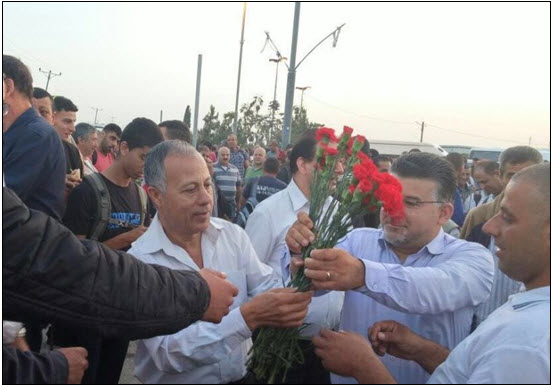Hadash and Communist Party of Israel (CPI) MKs began May Day on Sunday, May 1, by distributing flowers to Palestinian workers waiting to enter Israel via the Eyal checkpoint north of Kalkilya. “‘We appreciate your visit and the flowers, and we hope to find work today,’ was the common response we heard this morning,” Joint List MK Yousef Jabareen (Hadash) told The Jerusalem Post. “It has been a painful visit hearing many stories about the daily suffering of the workers. They arrive at the military checkpoint around 2 am in order to be able to enter on time,” he said.
Jabareen described the scene of thousands of Palestinian workers jammed into a holding facility, many of them not even sure they would find an employer to pick them up for a day’s labor. “Israeli employers are exploiting these vulnerable workers to avoid giving them their full rights and benefits,” told Jabareen. The CPI and Hadash marked the international worker’s day at the checkpoint along with its MKs and representatives in the Histadrut labor federation. On Saturday, the CPI and Hadash held two demonstrations for May Day in Nazareth, in the morning, and in Tel-Aviv in the evening. Thousands participated in the demonstrations and other activities around the country.

Hadash MKs Abdallah Abu-Ma’arouf, left, and Yousef Jabareen at Eyal checkpoint north of Kalkilya on May Day (Photo: Al Ittihad)
In an article appearing in the special May Day edition of Zo Haderech, the Hebrew-language weekly of the Communist Party of Israel (CPI), Raja Za’atry, a member of the Central Committee of the CPI wrote, “as the world marks International Workers’ Day, laborers in the Occupied Palestinian Territories (OPT) continue to suffer from soaring unemployment, poverty, and other dire working conditions. They are victims of a double exploitation: class and national.”
The average unemployment rate in the OPT was 26% in 2015: in the occupied West Bank, unemployment stood at 17%, compared to a staggering 41% in the besieged Gaza Strip, according to the Palestinian Central Bureau of Statistics (PCBS). Trade unions in the Gaza Strip estimate unemployment there has reached 60%. The PCBS estimates that some 336,000 persons are unemployed in the West Bank, while those without work in the Gaza Strip number 193,000.
Approximately 36% of wage earners in the private sector received less than the minimum wage in the OPT during 2015. Workers in the southern occupied West Bank district of Hebron were particularly vulnerable to being paid less than the minimum wage: there the average monthly salary was 986 shekels ($263.75), compared to the legal minimum set by the Palestinian Authority (PA) of 1,450 shekels ($387.85). In the Gaza Strip, workers fared even worse, with an average monthly wage of only 733 shekels ($196), as 67% of the workforce there earns less than minimum wage.
In 2015, the vast majority of workers in the OPT received no social benefits for their labor – only 21% of salaried employees received retirement or end of service compensation, while just 22% received paid annual leave, 23% paid sick leave, and only 35% of female salaried employees received paid maternity leave.
B’Tselem spokesperson Sarit Michaeli told Ma’an News Agency in March that Israel’s continued occupation of the OPT and its effective crippling of the Palestinian economy meant it was “obligated to find ways to bring Palestinian laborers into Israel.” The PCBS estimates that in 2015 there were as many as 36,400 undocumented Palestinian workers, although most of these were employed in illegal settlements.


